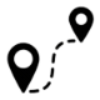Mariapeel, Deurnsche Peel and National Park Groote Peel
Cycling through an impressive peat landscape of pools, heathlands, sandy ridges, birch forests, and open plains.

The Landscape
The Deurnsche Peel and Mariapeel together form one of the last remnants of the vast raised bog that once covered large parts of southeastern Netherlands. Centuries of peat cutting have drastically transformed the landscape. What was once an impenetrable marsh is now a varied area of peat pools, wetlands, rough grasslands, heath, sandy ridges, and young birch forests. Cycle paths and boardwalks guide you past quiet pools and across open plains, where the landscape still radiates a sense of mystery and untouched nature.
On the border of Limburg and North Brabant lies one of the quietest and most unspoiled natural areas in the Netherlands: National Park Groote Peel. Once an impenetrable raised bog, it is now a rugged landscape of peat pools, heathlands, boardwalks, birch woods, and wide open plains where the wind roams freely. The park recalls a time when peat was known as black gold. Traces of old peat canals and excavation pits are still visible in the landscape. Thanks to its deep silence, open space, and natural darkness, De Peel has become one of the most bird-rich areas in Western Europe. Its iconic species is the crane, which can sometimes be seen here in autumn.

Forests and Heaths

Polders and Farmlands

Marshes and Peatlands

Lakes and Wetlands
Route map
Start and finish near bike node 32 on the Leegveld in Deurne. However, this bike route is a circular tour, so it offers the possibility to start from any of the following bike nodes.
32 - 37 - 39 - 03 - 43 - 44 - 89 - 45 - 87 - 70 - 94 - 5 - 7 - 8 - 95 - 20 - 22 - 21 - 96 - 15 - 25 - 27 - 57 - 26 - 6 - 32
- 63% of the route runs on paved roads.
- 37% of the route runs on unpaved and semi-paved paths.








